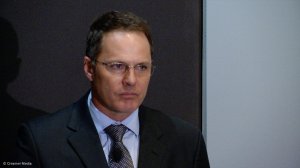JOHANNESBURG (miningweekly.com) – Acid mine drainage (AMD), which is water that has been polluted as a result of mining activity, is being used to relieve the cost burden of the large volume of water needed to recover gold from mine dump material, as well as lower the demand placed on scarce drinking water.
Surface mining company DRDGold revealed this week that it is currently receiving eight megalitres of treated AMD water a day from the government water organisation Trans-Caledon Tunnel Authority (TCTA), which is roughly the same quantity of treated sewage water that it receives daily from the sewage treatment plant operated by the East Rand Water Care Company. (Also watch attached Creamer Media video).
The Johannesburg- and New York-listed DRDGold requires large quantities of water to mine, pump and process tailings.
Its agreement with the TCTA allows for the sourcing of up to 30 Mℓ of treated AMD a day from the statutory water authority, which has built an AMD treatment facility on the site of the south west vertical shaft of DRDGold’s defunct East Rand Proprietary Mine (ERPM) in Germiston, where lime and limestone are used to neutralise the acidic water and precipitate the heavy metals in it.
By using treated AMD, sewage water and water harvested in terms of water usage licences, the company has succeeded in significantly limiting its use of potable water, which is part of a strategic intent articulated several years ago.
DRDGold CEO Niël Pretorius told investors, analysts and journalists at the presentation attended by Mining Weekly Online that in using AMD, care must be taken to avoid scaling of pipelines owing to the presence of reagents in the AMD.
“We’re happy that we can use treated AMD, but we’ve got to be clever about how much of it we put into our system,” he said of the company’s centralised water distribution system, which has been instrumental in lowering potable water use by 26% and total water use by 8%.
No water leaves the centralised system other than through evaporation. All the water that comes into the system remains in the system.
“It’s pushed into all the corners of the operation, making water far more manageable, predictable and cost effective," Pretorius told Mining Weekly Online.
Where DRDGold still uses considerable volumes of potable water is on its tailings dam vegetation programme, near Soccer City, however.
“To establish the vegetation and keep it going you need potable water. You can’t use treated water for that. That’s what makes the burning down of that vegetation an even bigger frustration for us, because it’s expensive water that goes on to those plants,” Pretorius told Mining Weekly Online. (Also access the Creamer Media video and article on the burning of vegetation using this link: https://www.miningweekly.com/article/expensive-mine-dump-vegetation-going-up-in-flames-drdgold-2017-09-05)
Questioned on the possibility of an AMD levy being applied to mines, as has been mooted, Pretorius said that DRDGold has a R250-million credit that is applicable in the event of a financial burden being brought about within the context of the treatment of AMD.
While not appearing in the financials, he said that this credit forms part of the arrangement when it placed its ERPM infrastructure at the disposal of the TCTA, which deposits on DRDGold's tailings dams.
As a strategic intent articulated four years ago, DRDGold goes all out to manage water sustainably, exemplified by no production being lost in the 12 months to June 30, which was one of South Africa’s driest periods.
DRDGold has a mineral reserve of three-million ounces in tailings dams scattered in and around the Johannesburg landscape, with 180 remaining from more than 300 originally.
Despite a cash outflow of R45-million in the 12 months to June 30, the company was still able to declare a dividend and thereby achieve a decade of uninterrupted dividend paying.
It is guiding a production of 138 000 oz for its 2018 financial year, up from 137 000 oz in the 12 months to June 30.
By taking material that has been thrown away and putting it through a process that yields gold, the company calculates that it adds R14-billion worth of value a year to the South African economy.
At the same time, it removes the environmental scars that mining has left behind and unlocks urban real estate for gainful development, Mining Weekly Online can report.
EMAIL THIS ARTICLE SAVE THIS ARTICLE ARTICLE ENQUIRY
To subscribe email subscriptions@creamermedia.co.za or click here
To advertise email advertising@creamermedia.co.za or click here










